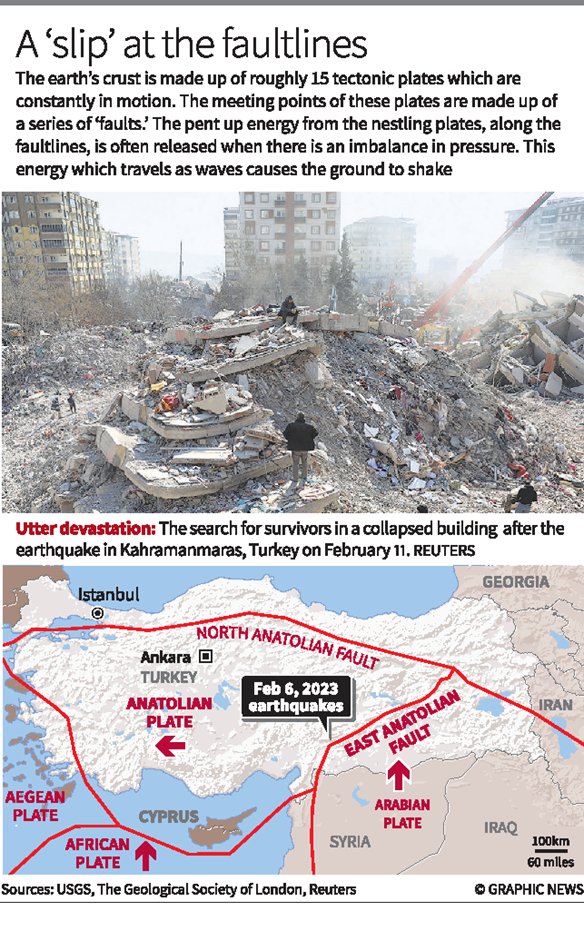Relevance : GS Paper- 1: Physical geography
Introduction:
Two large earthquakes hit South-eastern Turkey on February 6, causing widespread damage and claiming thousands of lives.
The first quake was of magnitude 7.8 followed by another of magnitude 7.5. The earthquakes have left a trail of destruction and many are still recovering from the impact.
In this blog, we’ll take a closer look at what caused these earthquakes, the type of earthquake that occurred, and why they were so devastating and deadly.
What Causes Earthquakes?
- The Earth’s crust is made up of tectonic plates that are constantly in motion
- Plate collision, push, and grating against each other create faultlines at the meeting points of these plates
- The pent-up energy along these faultlines is released when an imbalance in pressure causes rocks on either side of the fault to re-adjust
- The energy released travels as waves causing the ground to shake

What Kind of Earthquake Occurred in Turkey and Syria?
- Turkey and Syria lie at the confluence of three plates: the Arabian Plate, the Anatolian Plate, and the Eurasian Plate
- The region is seismically active due to the movement of the Arabian Plate into Europe and the pushing of the Anatolian Plate to the west
- The earthquakes were from a “strike-slip” which is typical of earthquakes in the region
Read Also: Major Earthquake In Turkey and Syria
Why Were These Earthquakes So Devastating and Deadly?
- The region is host to many fault systems and experiences many earthquakes, but only those with energy releases above a certain threshold are captured by seismological instruments
- The February 6th event was much larger than earthquakes the area has experienced before with a magnitude of 7.8
- The fault system runs along nearly 190 km, which is why the impact was so far-ranging
- The second earthquake, of 7.5 magnitude, occurred further to the north on a different but adjacent fault system, causing even more damage
- The magnitudes of these earthquakes suggest there will be several aftershocks that can be registered in a wide radius
- Reports of shakes from as far away as Cairo (950 km) and Istanbul (815 km) away have been reported
Similarities to Earthquakes in India:
- The Himalayas were formed by the Indian Plate colliding into the Eurasian plate and tilting upwards
- The most common type of earthquake in the Himalayan region is due to reverse faults caused by compressive forces between the two plates
- Scientists have warned of a massive, overdue earthquake in the Garhwal-Kumaon range in India
- Based on slip and strain measurements, scientists deduce that latent pressure is building up along a fault and that a major earthquake is overdue
- Records suggest that past earthquakes haven’t released all the pent-up energy, making a major earthquake likely
- Predictions of the day an earthquake will occur are beyond the current ken of science
Energy from Latent Pressure:
- Energy from nearly 300 years of accumulated strain was released in the Turkey-Syria earthquakes
- The magnitude of earthquakes does not correspond directly to death and devastation
- Chile, a country with a long history of devastating earthquakes, has low casualties due to strict enforcement of building codes
- The 9-magnitude earthquake in Fukushima did not damage the stability of the structure, but the cost of earthquake-proofing rises exponentially
- If structures are built on a fault line, no amount of engineering can save them
- A lack of enforcement of building codes and timing of earthquakes can lead to death and devastation, as seen in Turkey
- India has rules on building codes but limited enforcement, resulting in damage like the 1993 Latur earthquake
Conclusion:
The earthquakes in Turkey and Syria have been devastating, leaving a trail of destruction and claiming many lives. The region is seismically active due to the movement of tectonic plates, and the earthquakes were caused by the release of pent-up energy along these faultlines.
The magnitudes of these earthquakes and their far-ranging impact have made them particularly devastating and deadly.
It is important to remember the victims of these earthquakes and to continue supporting the relief efforts in the affected areas.
“Read Updated Daily Current Affairs, PIB And Editorial Here for UPSC 2023”
Legacy IAS Daily Current Affairs For UPSC
Legacy IAS Daily PIB Summary For UPSC
Legacy IAS Daily Editorial Analysis for UPSC
Legacy IAS YouTube Channel For Daily Current Affairs





